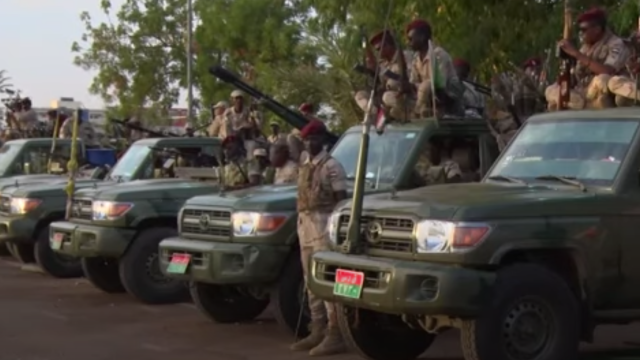We’ve known for a long time that Toyota’s Land Cruisers and Hilux pickup trucks are the go-to vehicles for armed groups of dubious legitimacy. You see them on the news all the time in locations across the Middle East and Africa. But how do these trucks, usually called technicals, make it from Toyota’s factories to the fleets of armed militants?
Global Witness, an organisation that works on understanding and subverting the intersection between resource exploitation and human rights abuses, thinks they have the answer, at least when it comes to some of the Land Cruisers and Hiluxes operated by the Rapid Support Forces, or RSF, a government-aligned militia group in Sudan largely composed of Janjaweed militias, the groups accused of committing genocide during the War in Darfur, sometimes called the Land Cruiser War for the heavy use of these Toyotas on all sides.
According to Global Witness, the Rapid Support Forces obtained more than a thousand Toyota vehicles in the first half of 2019. Global Witness alleges that these vehicles, a mixture of Land Cruiser 70 and Hilux pickup trucks, were purchased from a dealer in Dubai, transported across Saudi Arabia and the Red Sea and into Sudan where the RSF could put them into service.
But how did Global Witness track these Toyotas down? How do they know that they’re the same allotment of pickups? It’s rather impressive, actually.
Global Witness came into possession of an RSF spreadsheet detailing the purchase of vehicles from Dubai and managed to corroborate the details from the spreadsheet largely using images from social media, both from the RSF itself and others as well.
Starting with the spreadsheet itself, Global Witness contacted and confirmed that the dealers mentioned did indeed conduct transactions matching the prices, quantities, models, and other details mentioned in the documents. Some of these details were quite obscure, like the fact that some of the vehicles were 2019 models yet covered with decals from the prior model year. Those distinctive decals would prove crucial to identifying the pickups as they moved westward towards Sudan.
From there, Global Witness tracked the vehicles using social media posts. Tell-tale Gulf Cooperation Council emissions stickers placed on the drivers-side window helped identify the Hiluxes as social media posts captured the trucks in photos taken later on in June 2019, shortly after the June 3rd Massacre committed by the RSF and other government-aligned groups. Those same trucks had the out-dated decals on them as well.
But if the trucks could be identified with the dealers and the end-users, how did they get from Dubai to Sudan? Global Witness narrowed down the possible routes to one freight forward facility in Jeddah, Saudi Arabia. Photos taken at the Red Sea Service Centre seem to show numbers of the right Toyota models that correspond with the original spreadsheet, and a ship’s manifest further corroborates a transfer of Toyota vehicles from Jeddah to Sawakin on the Sudanese side of the Red Sea in the correct early-2019 timeframe.
From there, Global Witness used a remarkable array of social media photos and satellite imagery to help place car carriers full of Toyota pickups between Sawakin and Khartoum, the Sudanese capital during that same period. Between tracking the licence plates and decals on the vehicles themselves, the placement of light poles on major streets, and other minor details, the organisation believes it has traced the same Land Cruisers from their point of origination in Dubai Toyota dealers to the streets of Khartoum a few months later, largely working off a combination of open-source resources and just one leaked spreadsheet.
It’s a pretty remarkable effort and it demonstrates just how hard groups like the RSF work to keep their supply chains clean of scrutiny even when they make use of equipment sourced from major multinational corporations like Toyota. While the use of Toyota’s trucks might be alarming for the company from a communications perspective, Global Witness did make clear that it reached out to Toyota, and that it does not accuse the company of any wrongdoing in this case.
Nonetheless, once researchers expose the supply lines that feed these militant groups dual-use equipment like pickup trucks, it will likely become much easier to stem the flow, should manufacturers want to. If they do, it’ll be because of efforts like this one from Global Witness that make it happen. Take a look at their full report because the attention to detail is tremendously impressive. Let’s just hope their hard work pays off.
